CUSTOM METAL FORGINGS WHAT YOU NEED TO KNOW:
Piercing:
Forcing a punch into the hot upset stock causing metal to be displaced radially, as shown.
Shearing:
Serves to remove the small punch-out, producing a completed hole through the stock which is now ready for the ring rolling operation itself. At this point the stock is called preform.
The doughnut-shaped preform is slipped over the ID roll. The free-turning ID roll exerts force force against the OD roll which imparts a rotary action, resulting in a thinning of the section and a corresponding increase in the diameter of the ring. Once off the ring mill, the ring is then ready for secondary operations such as close tolerance sizing, parting, heat treatment and test/inspection.
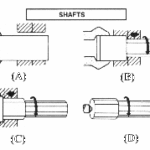
(A) Starting stock, held by manipulator.
(B) Open die forging.
(C) Progressive forging.
(D) Lathe turning to near net-shape.
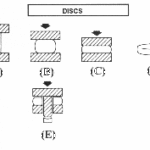 (A) starting stock.
(A) starting stock.(B) Preliminary upsetting.
(C) Progressive upsetting/forging to disc dimensions.
(D) Pierced for saddle/mandrel ring preform.
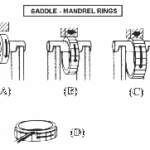 (A) Preform mounted on saddle/mandrel.
(A) Preform mounted on saddle/mandrel.(B) Metal Displacement reduce preform wall thickness to increase diameter.
(C) Progressive reduction of wall thickness to produce ring dimensions.
(D) Machining to near net shape.
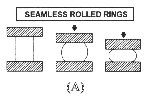
(A) The metal forging process typically begins with upsetting of the starting stock on flat dies at its plastic deformation temperature — in the case of grade 1020 steel, approximately 2,200 Fahrenheit. The upsetting operation introduces wrought properties to the starting stock and begins the development of a workpiece preform configuration that is conductive to subsequent steps.

(B) Piercing — forcing a punch into the hot upset stock causing metal to be displaced radially, as shown.
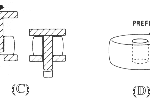
(C) Shearing serves to remove the small punchout…
(D) producing a completed hole through the stock which is now ready for the ring rolling operation itself. At this point the stock is called preform.
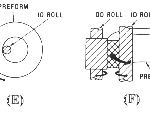
(E) The doughnut-shaped preform is slipped over the ID roll, shown here from an “above” view.
(F) A side view of the ring mill and preform workpiece. The free-turning ID roll exerts force force against the OD roll which imparts a rotary action…

(G) resulting in a thinning of the section and a corresponding increase in the diameter of the ring. Once off the ring mill, the ring is then ready for secondary operations such as close tolerance sizing, parting, heat treatment and test/inspection.
Contact Falcon Metals and Forgings
1-800-631-0728
NJ: 201-670-8300
CANADA: 800-544-5501
Fax: 201-670-0033
